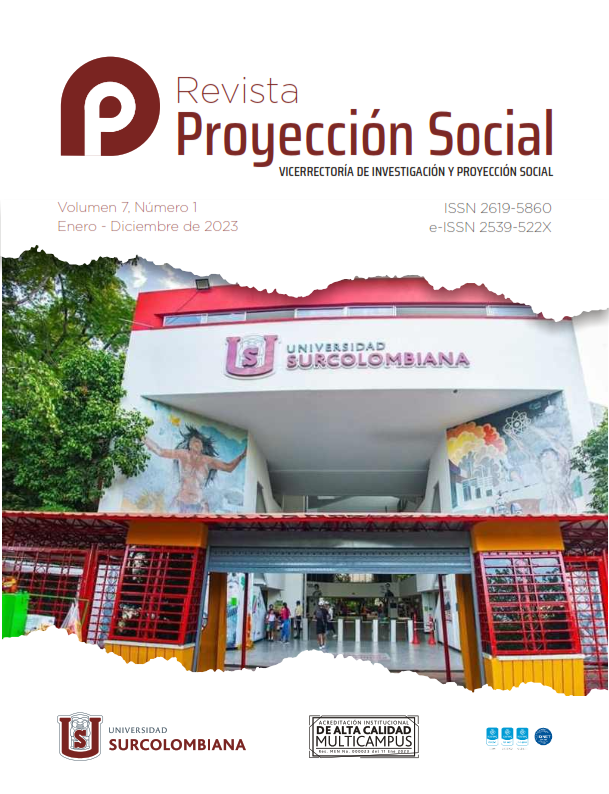The coffee sector in Huila, its contribution to competitiveness and the role of education. Period 2020- 2022
El sector cafetero en el Huila, su aporte a la competitividad y el papel de la educación. Periodo 2019-2022
##plugins.themes.bootstrap3.article.main##
The Department of Huila ranked first in coffee production in 2022, as reported in the management report of the National Federation of Coffee Growers FNC, with 21.3% (2.4 of the 11.7 million 60-kilogram bags) of the total. and an economy on which more than 83,000 families in the 35 producing municipalities depend. However, the level of coffee transformation is very low, even though our department contributed 19.3% of the total export of excellent coffee in the last year.Understanding these new economic dynamics, the department of Huila designed an internal productivity and competitiveness agenda, 2005 revised in 2016, as a strategy to guide the organized development of the region, for which it identified and documented 6 productive bets as the most strategic to strengthen the development of the region and one of them is related to agricultural products and the countryside, where the agricultural sector is led by the cultivation of coffee, which has been ratified in the Social Productive Property Management Plan - POPSP.Despite these efforts in the agricultural sector and specifically in Coffee, departmental competitiveness studies in
recent years place Huila between 15th in 2019 and 12th in the last publication and requires the regional leadership, otherwise public and private, try in terms of relevance, quality, and opportunity of education, to strengthen the business environment and invest in Research and Innovation. In the same way, it is necessary to promote the measurement and follow-up of the impact that efforts may have in improving variables that have an impact on increasing productivity in terms of efficiency in the use of resources,
environmental responsibility, and the knowledge that the members of the units may have. productive and in the case of coffee, coffee families.
Downloads
##plugins.themes.bootstrap3.article.details##
Bager, S., & Lambin, E. (2020). Sustainability strategies by companies in the global coffee sector. Buseiness Strategy and Environment, 3555-3570. doi:https://doi.org/10.1002 /bse.2596
Bernal, C. A. (2006). Metodologia de la Investigación. Mexico: Pearson educatión.
Comite de Cafeteros del Huila. (2023). Informe de gestión 2022. Neiva.
Consejo Privado de Competitividad -CPC. (2023). Índice Departamental de Competitividad (IDC) 2023. Bogotá.
Obtenido de https://compite.com.co/indice-departamental-de-competitividad/
Departamento Nacional de Estadistica DANE. (Mayo de 2023).PIB por departamento. Obtenido de https://www.dane.
gov.co/index.php/estadisticas-por-tema/cuentas-nacionales/cuentas-nacionales-departamentales
Diaz, D., Alvarez, B., & Ojeda, M. (2020). Competitividad regional y desdarrollo económico: una breve revisión de la literatura economica moderna. Revista de Economía Política de Buenos Aires, 109-153. Obtenido de https://ojs. econ.uba.
Gobernación del Huila. (2016). Agenda Interna - Plan Regional de Competitividad del Huila. Neiva. Obtenido de https://www.google.com/search?q=agenda+interna+de+productividad+y+competitividad+del+huila&rlz=1C1JZAP_esCO908CO909&oq=agenda+interna+de&aqs=chrome.1.6
i57j0i20i263i512j0i512j0i22i30l3.4991j0j4&sourceid=chrome&ie=UTF-8
Gobernación del Huila. (Diciembre de 2019). Plan de Ordenamiento Productivo Social de la Productividad. Obtenido de https://www.huila.gov.co/agricultura-ymineria/publicaciones/8913/popspr-plan-de-ordenamiento-productivo-social-de-la-propiedad-rural/
Gobierno de Chile. (2013). Diseño Metodológico de Índice de Competitividad Comunal/Ciudades. Obtenido de chromeextension://efaidnbmnnnibpcajpcglclefindmkaj/https://www.subdere.gov.cl/sites/default/files/documentos/indice_
competitividad_de_comunas_ciudades_metodologia.pdf
González Lopez, J., Duque orrego, H., & Dussan Lubert, C. (2006). CARACTERIZACIÓN TECNOLÓGICA DE CAFICULTORES.
CENICAFE, 167-186.
Hernandez Sapieri, C., Fernández Collado, C., & Baptista Lucio,P. (1997). Metodología de Investigación. McGRAW - HILL
INTERAMERICANA DE MÉXICO, S.A. Huila, S. d. (Julio de 2023). Huila.gov.co. Obtenido de
https://www.huila.gov.co/publicaciones/5032/evaluaciones-agropecuarias-476/
Kassahun, T. (2021). Adoption of garden coffee production technology package by smallholder farmers in Ethiopia. African Journal of Food, Agriculture, Nutrition and Development, 17989-18004. Obtenido de https://ajfand.net /Volume21/No5/Teshome19990.pdf
Manrique Ramos, L., Medina Chamorro, F., Rodriguez Bejarano, L., & Garcia Gomez, L. (2017). Transformation of Colombian small coffee growers and new scenarios for their competitiveness. Globalisation And Small Business, 120-143.
Manrique, M., Medina, F., Rodriguez, L., & Garcia, L. (2017). Transformation of Colombian small coffee growers and new scenarios for their competitiveness. Globalisation and small business, 120-143.
Martínez De Ita, M. (1998). EL CONCEPTO DE PRODUCTIVIDAD EN EL ANÁLISIS ECONÓMICO. Obtenido de https://oa.mg/work/1543222666
Medina Fernández de Soto, J. (Julio-Diciembre de 2010).
Modelo de productividad, aspectos importantes para su implementación. Revista EAN, 110-119. Bogota. Obtenido de http://www.scielo.org.co/scielo.php?script=sci_arttext&pid=S0120-81602010000200007
Mendieta izquierdo, G. (2015). Informante y muestreo en investigación cualitativa. Investigaciones Andina(30), 17, 1148-1150.
Ministerio de Agricultura. (2021). Cadena de café. Obtenido de chrome-extension://efaidnbmnnnibpcajpcglclefindmkaj/https://sioc.minagricultura.gov.co/Cafe/Documentos/2021-03-31%20Cifras%20Sectoriales.pdf
Oviedo-Celis, R., & Castro-Escobar, E. (2021). Un análisis comparativo de la sostenibilidad de sistemas para la producción de café en fincas de Santander y Caldas. Cien y Tecnologia Agropecuaria, 22(3). doi:https://doi.org/10.21930/
Pérez Toro, J. (2013). Economía cafetera y desarrollo económico en colombia. Bogotá: Fundación Universidad de Bogotá Jorge Tadeo Lozano.
Sarmiento, A. (2013). Educación, calificación y formalización de la mano de obra en el sector cafetero. Universidad del Rosario.
Suarez, A., Gutierrez-Montes, I., Ortiz-Morea, F., Suarez, J., DiRenzo, J., & Casanoves, F. (2022). Contribution of Livelihoods to the Well-Being of coffee-Growing Households in the Southern Colombia: A structurak equation Modeling Approach. Sustainability 2022, 743.
doi:https://doi.org/10.3390/su14020743
U n i v e r s i d a d d e l o s A n d e s . ( 2 0 1 9 ) . O b t e n i d o d e https://uniandes.edu.co/es/noticias/sociologia/mujerescafeteras-rompen-brechas-historicas-en-colombia



